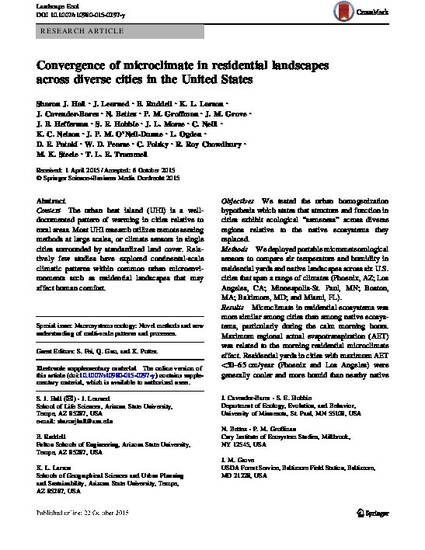
- Urban heat island,
- Urban sustainabilty,
- Ecosystem,
- Environment -- United States,
- Microclimate
Context The urban heat island (UHI) is a welldocumented pattern of warming in cities relative to rural areas. Most UHI research utilizes remote sensing methods at large scales, or climate sensors in single cities surrounded by standardized land cover. Relatively few studies have explored continental-scale climatic patterns within common urban microenvironments such as residential landscapes that may affect human comfort.
Objectives We tested the urban homogenization hypothesis which states that structure and function in cities exhibit ecological ‘‘sameness’’ across diverse regions relative to the native ecosystems they replaced.
Methods We deployed portable micrometeorological sensors to compare air temperature and humidity in residential yards and native landscapes across six U.S. cities that span a range of climates (Phoenix, AZ; Los Angeles, CA; Minneapolis-St. Paul, MN; Boston, MA; Baltimore, MD; and Miami, FL).
Results Microclimate in residential ecosystems was more similar among cities than among native ecosystems, particularly during the calm morning hours. Maximum regional actual evapotranspiration (AET) was related to the morning residential microclimate effect. Residential yards in cities with maximum AET \50–65 cm/year (Phoenix and Los Angeles) were generally cooler and more humid than nearby native shrublands during summer mornings, while yards in cities above this threshold were generally warmer (Baltimore and Miami) and drier (Miami) than native forests. On average, temperature and absolute humidity were *6 % less variable among residential ecosystems than among native ecosystems from diverse regions.
Conclusions These data suggest that common residential land cover and structural characteristics lead to microclimatic convergence across diverse regions at the continental scale.
To the best of our knowledge, this work was authored as part of one or more contributor's official duties as an Employee of the United States Government.
This is the publisher’s final pdf. The original article can be found online at: http://dx.doi.org/10.1007/s10980-015-0297-y.
